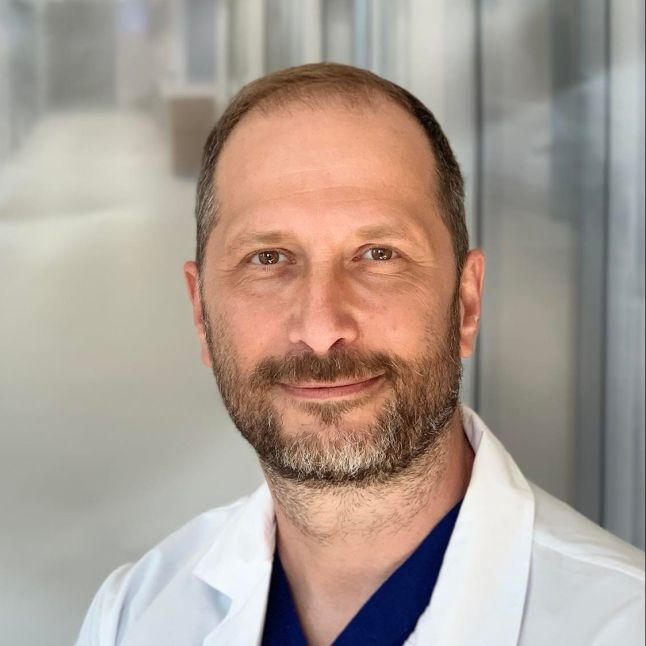 Gynaecology is the medical specialty that deals with diseases of the female reproductive organs and their treatment. Certain gynaecological problems can only be treated surgically. Gynaecological surgeries are always preceded by a specialist examination, and in justified cases, additional laboratory and imaging procedures as well. Regular gynaecological screening is indispensable for diagnosing often symptomless changes. Early recognition of these gynaecological problems is a crucial condition for effective treatment.
Gynaecology is the medical specialty that deals with diseases of the female reproductive organs and their treatment. Certain gynaecological problems can only be treated surgically. Gynaecological surgeries are always preceded by a specialist examination, and in justified cases, additional laboratory and imaging procedures as well. Regular gynaecological screening is indispensable for diagnosing often symptomless changes. Early recognition of these gynaecological problems is a crucial condition for effective treatment.
Gynaecological surgeries can be carried out in various surgical ways depending on the type of problem. Hence, we can talk about laparoscopic surgeries, where therapeutic interventions occur within the abdominal cavity, hysteroscopic interventions, or uterine mirrorings, where we reach the uterine cavity through the vagina, and there may also be situations that require open abdominal surgeries. You can read in detail about these surgical methods by clicking here.
Below, we provide information about the most common surgeries performed on the uterus.
Abrasion, or curettage in healthcare
Abrasion, also known as curettage, is the most frequently performed gynecological intervention. During the operation, the endometrium is removed and then histologically examined, so that both benign and malignant diseases can be diagnosed. In the case of certain lesions, the curettage is also a curative intervention.
Correctage may be justified in case of abnormal uterine bleeding, it can identify the lesion behind the bleeding disorder. Bleeding disorder can be caused by:
- hormonal abnormalities
- inflammatory diseases
- benign and malignant tumors
When do we call bleeding abnormal?
- bleeding after menopause - we always consider it abnormal, if you experience period bleeding, contact your gynecologist immediately!
- spotting or heavy bleeding between periods or after sex
- a larger-than-normal amount of menstruation (e.g. it is considered such a case if tampons or pads need to be changed every 1-2 hours)
- the duration of menstruation is longer than normal (its duration exceeds 7 days)
- menstrual bleeding occurs several times a month (more often than 24 days)
The patient's anamnesis (medical history) and age are of course very important factors in determining the origin of the disease, but a definite diagnosis can be obtained with the findings of the abrasion and the subsequent histological examination. Based on this, it becomes clear whether it is a harmless change or a possibly malignant tumor.
Exactly what diseases can cause abnormal bleeding?
- Polycystic ovary syndrome (PCOS): a common condition associated with dysfunction of the ovaries; irregular menstruation is characteristic, which sometimes misses for a long time, and then appears in a very strong form when it returns
- Pelvic inflammatory disease (PID-pelvic inflammatory disease): inflammation of the upper genital system (uterus, fallopian tubes, ovaries), which can be accompanied by pelvic or lower abdominal pain, heat/fever, foul-smelling discharge and abnormal bleeding (between periods or after sexual intercourse)
- myoma/fibroma: a non-cancerous growth in the wall of the uterus, which can be accompanied by heavy, sometimes painful menstrual bleeding
- adenomyosis (adenomyosis): the tissue that normally lines the uterine cavity is abnormally embedded in the wall of the uterus
- endometriosis: the appearance of endometrial tissue lining the uterus outside the uterine cavity, such as in the fallopian tubes, ovaries, vagina, bladder; dangers: painful, heavy menstrual bleeding, pelvic inflammation, infertility
- hypothyroidism (hypothyroidism): as a result of underfunctioning thyroid gland, it does not produce enough hormones, which can be associated with fatigue, weight gain and a feeling of depression; therefore, when investigating a bleeding disorder, a blood test (TSH) may also be necessary if hypothyroidism is suspected
- polyps: benign growths in the uterus or cervix
- blood coagulation disorders , such as Von Willebrand's disease, which is caused by a qualitative or quantitative deficiency of coagulation factor number 8; examination: through a blood test, which shows a lower than normal platelet count (thrombocyte) and increased APTI (activated partial thromboplastin time - a procedure for testing blood coagulation) values
- uterine carcinoma/uterine cancer: a malignant neoplastic change of the endometrium, which usually occurs after menopause
- Following medical treatments:
- Insertion of an IUD (contraceptive spiral): heavier than normal menstrual bleeding may occur 3-6 months after the insertion of the intrauterine contraceptive device
- anticoagulation therapy
- some chemotherapy drugs
For these reasons, it is important to contact your gynecologist in the event of abnormal bleeding and/or the occurrence of the above symptoms. In many cases, traditional examination procedures (two-handed gynecological examination, ultrasound, blood test) are not able to give an accurate diagnosis, in which case the curettage may be the solution.
The course of the operation
If the decision has been made about the need for abrasion, the first step in pre-operative preparation is the anesthetist (anesthesiologist) consultation. The anesthesiologist assesses the patient's general medical condition (based on medical history, laboratory findings, EKG, other tests) and decides on the feasibility of the intervention based on this.
The intervention can be performed under anesthesia or local anesthesia and, in the absence of comorbidities, can be performed within the framework of one-day care, so the patient can go home after a few hours of observation after the operation.
During curettage, the cervix is slightly dilated with increasingly large metal sticks (Hegar sticks), so that the curettage spoon can be inserted into the uterine cavity. Using the curette spoon, we systematically move along the walls of the uterus and the cervix, removing the mucous membrane with the sharp side of the spoon. The scraping is then sent for histological examination. The intervention usually takes no longer than 15 minutes.
Possible complications
Complications can develop despite medical intervention carried out with the greatest care.
- Despite the greatest care, it is possible that the wall of the uterus is inadvertently pierced with the thin instrument. It is mostly harmless and does not require treatment, only observation. In the event of a major injury or bleeding, an extension of the operation (by laparoscopy or laparotomy) may become necessary in order to restore or stop the bleeding.
- Inflammation can occur after any surgery, which can be treated with antibiotics if necessary. If bleeding, foul-smelling vaginal discharge, lower abdominal pain, or fever/heat persisting for more than 2-3 days after surgery, contact your operating physician immediately so that targeted treatment can be started as soon as possible.
- Post-bleeding that occurs a few days after surgery is a well-known consequence of the procedure. If you experience bleeding that is heavier than menstrual bleeding or that lasts longer, see your doctor.
Things to do after the bee scraping
After a few hours of observation after the operation, if the patient feels well, can eat, drink, urinate and the operation was uncomplicated, he can go home. You can usually return to your daily activities the day after surgery. On average, the healing process does not last longer than 2-4 days, during which time heavy physical exertion should be avoided. In the 2 weeks following the operation, vaginal intercourse, tampon use, vaginal irrigation and bathing in the bathtub/swimming pool are not recommended. A control examination is required 4-6 weeks after the operation.
You must apply for the results of the histological examination 2 weeks after the intervention, and then, depending on the nature of the lesion, the further treatment strategy will be discussed with your doctor. A gynecological control examination is required 4-6 weeks after the operation.
Diagnostic Hysteroscopy
During hysteroscopy, the inner cavity of the uterus is examined with a special endoscope, the hysteroscope. The device is passed through the vagina, cervix and cervix into the uterine cavity.
During the intervention, the tissues of the endometrium and uterus can be thoroughly examined, thereby excluding or confirming benign and malignant lesions.
What complaints may require diagnostic hysteroscopy?
If any intrauterine lesion is suspected during other imaging diagnostic tests, such as ultrasound, X-ray, CT, MR. These can be e.g. the fibroid, polyp or tumor. If repeated miscarriages occur, or in case of infertility, it may be necessary to perform a diagnostic hysteroscopy in order to find out the causes. In case of bleeding disorders, especially after menopause, the use of this diagnostic procedure may also be justified.
During the examination, it is also possible to treat and surgically resolve certain detected lesions. In this case, the intervention is called operative hysteroscopy.
The operation can be performed under intravenous anesthesia or local anesthesia combined with mild sedatives. The device is passed through the cervix into the uterus. In case of surgical intervention, dilation of the cervix is also necessary. Through the camera on the hysteroscope, the inner surface of the uterus and the endometrium of the fallopian tubes become visible, and possible changes can be discovered, e.g. polyps, fibroids, adhesions, malformations or malformations.
Termination of pregnancy (abortion) before the 12th week
Termination of pregnancy, i.e. interruption or artificial abortion, is a medical intervention during which an unwanted pregnancy is terminated by a small operation. One in three women will have an abortion once in her lifetime.
In Hungary, the conditions for termination of pregnancy are defined in the LXXIX of 1992. Defined by law.
The age of the pregnancy is calculated from the first day of the last menstrual period, if you are not sure about this date, we can get an approximate picture of the age of the fetus by ultrasound examination. Nowadays, the interruption procedure is much safer than it used to be.
About the decision:
Some women are absolutely certain that they want an abortion, while for others the decision is a big dilemma. It is important to emphasize that there are many things to consider before making a decision, but the right to decide is of course only yours.
As a first step, all women must make an appointment and visit the Family Protection Service and participate in a consultation, where they will explain the options and help them make a decision. The employee of the Family Protection Service must submit the application in person, along with a certificate issued by an obstetrician-gynecologist, confirming the pregnancy (using a rapid pregnancy test and ultrasound).
This measure aims to ensure that the decision on the life of the fetus is sufficiently substantiated. Also, share and ask for advice from anyone with whom you are happy to share this fact, for example your family, your partner. If you do not want to share it with anyone, of course no one but you will know about the fact of pregnancy and abortion.
In our institution, we perform artificial abortions up to the 12th week of pregnancy, if surgery is required
-
- it is justified by a reason seriously endangering the health of the pregnant woman
- the fetus is medically likely to suffer from a severe disability or other impairment
- pregnancy is a consequence of a crime
- in the event of a serious crisis of the pregnant woman.
About the intervention
With the permission of the Family Protection Service, visit your doctor, who will make an appointment for the operation.
Vacuum aspiration can be performed under anesthesia or local anesthesia. Similar to the uterine scraping, the first step is to stretch the cervix with metal sticks of increasing diameter (Hegar series) successively inserted into the cervical canal. After reaching the appropriate space, a slightly bent suction tube (vacuum aspirator) is guided into the uterine cavity. With the help of the device, the contents of the uterus are sucked out and emptied. Finally, we perform a uterine scraping with the curette spoon, by which any remaining fetal tissues and appendages in the uterus are completely removed. The intervention usually takes no more than 10-15 minutes.
After a few hours of observation after the operation, patients can return home if no complications have occurred.
Possible complications:
Complications can develop despite medical intervention carried out with the greatest care.
- It is important to emphasize that during the intervention the operating doctor works "blind", he only knows where the intervention is based on feeling and hearing. Thus, despite the greatest care, it is possible that the wall of the uterus is punctured by the surgical instrument. This is mostly harmless and it does not require treatment, only observation.In case of major injury or bleeding, in order to restore or stop the bleeding, it may become necessary to extend the operation (by laparoscopy-mastroscopy or laparotomy-abdominal incision).
- Uterine infection can also occur, as bacteria can migrate from the vagina to the uterine cavity as a result of the dilation of the cervical canal. Abdominal pain and fever can draw attention to the infection. We can end the condition with antibiotic treatment.
- Retention of fetal appendages in the uterine cavity, which can cause inflammation and heavier bleeding and can be treated with a repeated curettage or antibiotics.
- Blockage of the fallopian tube can occur as a result of uterine infection. This can make it difficult to get pregnant later, or require reconstructive surgery or bottle-feeding treatment.
- During subsequent pregnancies, uterine adhesion disorders may occur, which can endanger the pregnancy (cause bleeding) and make it difficult to expel the placenta after delivery. Then another uterine scraping, or even hysterectomy in case of ineffectiveness, can be considered as a solution.
- Heavy bleeding may rarely occur. Then the extension of the operation to a laparotomy (abdominal incision) may become necessary.
The complications mentioned above are very rare. It is important to emphasize that the probability of complications increases with advancing gestational age. If the described complications occur, they require further treatment, possibly surgery (as can be read in the examples). In most cases, after an abortion, the chance of a natural pregnancy later on and of carrying it to term in a healthy way does not decrease.
Dull lower abdominal pain and vaginal bleeding are known to be associated with the procedure, which can usually last for 1-2 weeks. Light bleeding may occur for up to a month. In case of pain, it is recommended to use a product containing ibuprofen, and in case of bleeding, use a sanitary pad (not a tampon, as this may increase the risk of infection).
If you experience heavy bleeding or pain, foul-smelling vaginal discharge or fever, or symptoms typical of pregnancy (nausea, vomiting, breast tenderness), notify your doctor immediately.
After the abortion:
If there are no complications, the uterine lining regenerates after a few menstrual cycles. It is important to know that it is usually possible to get pregnant again immediately after an abortion, so if you feel ready to have sex (usually not recommended until the first menstrual bleeding), it is important to use a reliable contraceptive method! If you want to get pregnant again, it is recommended to wait until after 2-3 normal cycles, and until then protect yourself with a rubber condom. After that, you can safely undertake a subsequent pregnancy without further ado.
Interruptio is therefore a very safe procedure, but it is important to point out that it can have many health risks, emotional and physical consequences. That is why we encourage everyone to use the appropriate contraceptive method, the selection of which our obstetrician-gynecologists are happy to assist you!
Surgical Completion of Spontaneous Miscarriage (Curettage in Cases of Incomplete Abortion or Missed Abortion)
Spontaneous miscarriage is the termination of pregnancy before the 24th week of pregnancy, if the fetus does not show any vital signs at birth and weighs less than 500 grams, and the miscarriage occurred without any detectable external influence. During the operation, the pregnancy tissue remaining after the spontaneous abortion and the dead pregnancy are emptied from the uterus.
Some of the miscarriages already occur before the Klinjka diagnosis, which is only perceived by those involved as menstruation that is more abundant than usual, longer than usual, or occurring a few days late. According to some estimates, up to 30-40 percent of conceived pregnancies are terminated in this early period. This can be caused by the fact that the embryo was not viable, healthy, or there were problems with implantation.
Even if the pregnancy is recognized, early spontaneous abortions still occur, with an estimated 15-20% of cases resulting in loss. However, if it occurs after approximately 7 weeks from the first day of the last period, it will not go unnoticed: in addition to uterine contractions stronger than menstrual cramps, blood, blood clots and the embryo itself are also expelled from the uterine cavity.
Before the 16th week of pregnancy, miscarriage usually occurs in a single stage, at which time the fetus and its appendages (membranes, placenta) leave together. From the 16th week, a miscarriage – like childbirth – has two stages: first the fetus leaves, then the placenta. In both cases, there are warning signs of miscarriage in the form of bleeding and lower abdominal pain.
Early miscarriage, as a collective term, includes the following cases:
- We are talking about an incipient miscarriage (abortus incipiens) if the cervical canal is open, but the fetus and/or appendages have not yet left.
- We speak of an incomplete abortion (abortus incompletus) if the fetus and/or its appendages have already left, but the uterus has not emptied completely,
- Abortion is complete or complete if the uterus is completely emptied (abortus completus).
- We speak of a missed abortion when the fetus dies, but its expulsion does not start spontaneously.
During the operation, the pregnancy tissue remaining after the spontaneous abortion and the dead pregnancy are emptied from the uterus. The surgical termination of the abortion is necessary because the remaining pregnancy tissue can cause prolonged bleeding, severe uterine or pelvic inflammation, and adhesions can form in the uterine cavity. During the operation, we ensure that no fetal or fetal appendages or blood clots remain in the uterine cavity. Without the intervention, infertility may develop, or in case of more serious complications, it may even become necessary to remove the uterus.
The procedure is different for women who have given birth before or for women who have not yet given birth, and depending on whether the miscarriage took place before or after the 12th week. The operation is performed under local anesthesia or short-term anesthesia.
In the case of a miscarriage that has already started, we ensure that the process takes place spontaneously, under sterile conditions. In case of suspicion of an inflammatory origin, we also use antibiotics.
Before the next pregnancy, the underlying disease causing the miscarriage should be identified. There can be countless reasons behind it, from insufficiency of the corpus luteum to the existence of an infectious disease, through insufficiency of the cervix to chromosomal abnormalities.
Conization (conisatio), also known as cone biopsy of the cervix
Cone excision or conization may be performed due to abnormally transformed cells detected during cervical cancer screening (colposcopy and Pap smear) due to HPV virus infection (CIN = cervical intraepithelial neoplasia, change in the epithelial layer of the cervix, pathologically degenerated epithelium). Pathologically degenerated (dysplastic) epithelial cells rarely transform into malignant cervical cancer, however, without treatment, any patient has the chance of the cells transforming into a malignant tumor over time. During cone excision, these abnormal, dysplastic cervical cells are removed.
The purpose of conization is to remove and histologically examine the lesion found during cancer screening. With the help of the histological findings, we get an accurate diagnosis regarding the degree of malignancy of the cells that make up the lesion. In addition, the removed piece of tissue also reveals whether it was excised intact, i.e. whether the removal was perfect or whether there were still degenerated cells in the cervix.
How is cone excision performed?
The intervention is performed under anesthesia and usually takes no longer than 15-20 minutes. During the operation, a cone-shaped part of a few centimeters is excised from the vaginal end of the cervix, which contains the pathologically degenerated epithelial cells. There are two types of cervical cone dissection:
- So-called cold knife technique: during which the intervention is performed with a scalpel and stitches are placed on the wound edges. The advantage of this technique is that the histological examination of the wound edges can be perfect. The disadvantage is a greater risk of bleeding.
- Conization with a loop hook: the tissue cylinder is removed with an electric knife, the advantage of which is that it simultaneously reduces and stops bleeding during cutting. The disadvantage is that, as a result of the burning technique, the histological examination of the wound edges does not give clear findings in all cases.
When choosing the type of surgery, your doctor will consider several factors:
- extent and severity of the lesion
- your age
- possible menstrual bleeding disorders
- Your decision, aspects, and possible co-morbidities
It is important to point out that the operation cannot be performed during pregnancy, so it is necessary to make sure that there is no pregnancy before - if there was unprotected intercourse after the previous menstrual bleeding.
Why is cone excision recommended?
The success rate of the intervention is 95%. This is to be understood in terms of the results of the control cancer screening 6 months later, so 95% of the smears give a normal, i.e. negative, result again.
What are the consequences and complications of surgery?
As with all other medical interventions and surgeries, side effects and complications may occur in the case of conization, albeit rarely:
- Heavy bleeding during or 10 to 14 days after surgery
- An infection that may require antibiotics
- Rarely, cervical insufficiency can occur after surgery, which means a decrease in the ability of the cervix to close. As a result, the chance of premature birth and premature rupture of membranes (resulting in amniotic fluid leakage) increases minimally during subsequent pregnancies. It is important to emphasize that the intervention does not cause infertility or miscarriage later on.
- In 1 out of 5 cases, the cervical canal may narrow as a result of scarring. This complication may later require another operation, during which the patency of the cervical canal is restored.
If you have any questions or concerns about the operation or its complications, your doctor will be happy to answer. In each case, the intervention is carried out by assessing the possible risks and benefits, after comparing them.
What can I expect after the intervention?
During the operation, a catheter is inserted into the bladder, which can usually be removed within 24 hours after the procedure. After cone excision, it is necessary to lie in bed for a few hours, during which the occurrence of possible heavier bleeding can be ruled out. In some cases, you can go home on the day of the procedure, in the evening, but sometimes a 24-48-hour hospital stay is necessary.
Post-conization advice, which can facilitate recovery, helps:
- Pain relief: In many cases, patients do not feel pain after the procedure. If you still experience abdominal or pelvic pain, you can take paracetamol-containing painkillers according to your doctor's instructions (follow your doctor's instructions, never take more than the permissible dose!).
- Bleeding: Some bleeding, brownish-black or transparent vaginal discharge usually occurs up to 6 weeks after surgery. You may experience changes in the strength and frequency of menstrual bleeding for 2-3 months. Avoid using sanitary tampons for 4 weeks after the procedure. If heavy, red bleeding or foul-smelling discharge occurs, notify your doctor as soon as possible.
- Sexual intercourse: In order to minimize the chance of bleeding and infection, it is recommended to avoid vaginal intercourse for 4 weeks.
- Returning to work and daily activities: Avoid baths and swimming for 2 weeks. Usual activities - including light exercise - can be continued with pre-operative activity. Return to work at your own discretion and well-being. As a result of the anesthesia, rest for at least 24 hours is recommended.
- Alcohol consumption: Moderate alcohol consumption is allowed, unless you need to take an antibiotic containing metronidazole after surgery. In this case, alcohol cannot be consumed.
After surgery, a control examination is recommended at a time agreed with your doctor.
Can the malignant change (dysplasia) return?
In some cases, the lesion may return, which most often occurs 2-3 years after the intervention. Therefore, regular gynecological cancer screening is recommended even after the operation - annually, or every 6 months in the case of HPV infection.
Hysterectomy
Hysterectomy, i.e. hysterectomy (pronounced: hysterectomy) is a gynecological surgical procedure in which the uterus is removed. Consequently, after the intervention, monthly bleeding does not occur and pregnancy is no longer possible. The surgery is most common among women aged 40-50.
A hysterectomy is a large-volume operation with a long recovery time, so it is only justified if other, less invasive (penetrating into the body cavity) treatments have already been tried, but still did not prove to be sufficient to cure the given disease. An exception to this may be malignant tumors, the only possible treatment of which - in an advanced stage - is hysterectomy.
Depending on the condition that necessitates hysterectomy, three types of hysterectomy may be considered.
Types of hysterectomy:
- partial
- total
- radical
What diseases may require a hysterectomy?
- Excessive menstrual bleeding: If menstrual bleeding is regularly accompanied by a large amount of severe lower abdominal pain and cramps, it can significantly affect the quality of life. In some cases, this can be caused by a myoma (myoma in Hungarian, a benign tumor of the muscle layer of the uterus), but it can often occur without any organ abnormalities. In some cases, removal of the uterus may be the only solution (if other medical treatments have not worked, menstrual bleeding significantly affects the quality of life, and you no longer wish to have more children).
- Long-standing pelvic pain:
- Bacterial pelvic inflammation (PID-pelvic inflammatory disease), which can be treated with antibiotics if detected in time, but in other cases can spread and damage the uterus and fallopian tubes, which leads to long-term pain. Hysterectomy can be an optimal solution for women who suffer from this disease and do not wish to become pregnant in the future.
- Endometriosis: The essence of the disease is that endometrium is found outside the uterine cavity, anywhere in the body. Most often in the ovaries, fallopian tubes, bladder and rectum. The tissues surrounding the ectopic cells can become inflamed, leading to tissue damage. Symptoms and possible complications may include: pain, heavy and irregular menstruation, infertility. If endometriosis affects the uterus and other, less radical treatments do not prove to be effective and the patient no longer plans to have children, hysterectomy can provide a definitive solution.
- Prolapse of the uterus: Uterine prolapse due to the weakness of the ligaments that stabilize the uterus and the muscles of the pelvic floor, which is often caused by the process of childbirth. The symptoms can be: back pain, feeling of a foreign body in the vagina, urinary retention complaints, difficulties during sexual intercourse, pain. Hysterectomy can solve the complaints, since the uterus that has lost its support is removed.
- Benign tumors of the uterus, most often myoma (myoma): symptoms can be: painful, heavy menstrual bleeding, lower abdominal pain, frequent urination, constipation, pain during sexual intercourse. A hysterectomy is justified if the tumor causes large or heavy bleeding and you no longer wish to have more children.
- Malignant tumors of the uterus, cervix, ovary(s) and fallopian tubes: if the tumor is detected at an advanced stage, hysterectomy may be the only treatment option.
What should be considered before surgery?
If your doctor has established the diagnosis of your disease, which is to be treated by hysterectomy, the next step is to determine the method of surgery. This means whether the cervix and ovaries should also be removed, if applicable. This decision depends on your past medical history, your doctor's recommendation, and your personal opinion.
It is important for your decision to be aware of the methods of hysterectomy and the possible consequences of each type of surgery.
What are the types of hysterectomy?
The following factors play a role in choosing the type of surgery: your underlying disease(s) and whether the surrounding genitalia can be safely left in (i.e., whether there is a positive family history of ovarian and/or breast tumors). The main types of surgery:
- Subtotal hysterectomy (Amputatio supravaginalis corporis uteri s.Chrobak), Chrobak operation: only the uterus is removed, the cervix and ovaries remain in place.
- Total hysterectomy: removal of the uterus and cervix.
- Total hysterectomy with bilateral salpingo-oophorectomy: removal of the uterus, cervix, fallopian tubes (oophorectomy), and ovaries (oophorectomy).
- Radical hysterectomy: removal of the uterus and surrounding tissue, including the fallopian tubes, ovaries, lymph nodes, fatty tissue, and part of the vagina. This procedure may be necessary in the case of malignant tumors, if chemotherapy or radiation therapy is not suitable for the patient or has not proven to be effective.
Subtotal hysterectomy, Chrobak operation:
During the operation, the uterus is removed, but the cervix is preserved. As a result, the patient's menstruation may continue to a small extent - as an indication - and cervical cancer screening must also be performed regularly. The great advantage of the procedure is that the preserved cervix ensures continuity between the ligaments that attach the surrounding organs, so the vagina remains fixed in its original position. Since the vagina is not shortened and the uterine nerve plexus is not damaged, sexual pleasure is not reduced.
The operation is performed using a laparoscopic technique, through small holes made in the abdominal wall, without cutting the abdominal wall, which ensures a faster, risk-free and almost scar-free recovery.
Total hysterectomy:
During the procedure, in addition to the uterine body, the cervix is also removed. If you have a malignant tumor of the cervix, ovary, or uterine body, radical hysterectomy can prevent the spread of the tumor in many cases. If not, it can still help increase the effect of chemotherapy, the anti-tumor function of the immune system, which improves survival. If you do not have a tumor, the possible subsequent tumor formation can be prevented by removing the cervix. But of course, this is entirely up to you. Many women do not agree to have their cervix removed because they want to keep as much of their reproductive system as possible.
Total hysterectomy and removal of the ovaries (salpingo-oophorectomy):
In addition to the uterus (and sometimes the cervix), the ovaries (ovaries in medical terms) and fallopian tubes are also removed. This is necessary if there is an increased risk of a later disease, such as ovarian cancer. If there is a history of malignant ovarian and/or breast tumors in your family, these diseases can be prevented by removing the ovaries. In women who have gone through menopause (or are close to menopause), the procedure is usually also performed to prevent cancerous lesions of the ovary, even in the case of a negative family medical history. But healthy ovaries may be worth leaving inside, as they produce many hormones that play a role in preventing osteoporosis (osteoporosis, which manifests itself in weak and fragile bones), and in maintaining libido and sexual pleasure. The need to remove the ovaries can often only be revealed during the hysterectomy, so it is worth discussing in advance with the operating doctor whether you agree to the removal of the ovaries - for the purpose of cancer prevention.
By which surgical interventions is it possible to perform a hysterectomy?
- Vaginal hysterectomy: Removal of the uterus and cervix through the vagina using special instruments. The procedure usually takes an hour and is performed using anesthesia or spinal anesthesia. Hysterectomy through the vagina is less invasive, so it requires less time spent in the hospital and is associated with faster recovery and less pain.
- Abdominal hysterectomy: The uterus (with or without the cervix) is removed through an incision in the lower abdomen. Abdominal hysterectomy is required if the patient has a large fibroid or malignant pelvic tumor, or if the ovaries need to be removed. The incision can be horizontal (in the bikini line) or vertical (in the middle of the abdomen, in the line connecting the navel and the bikini line). The latter is usually used to remove myoma nodules and some malignant tumors. The intervention can be performed in about an hour and is performed under general anesthesia.
- Laparoscopic hysterectomy (keyhole surgery): The uterus is removed in small pieces after shredding with laparoscopic instruments. The procedure is performed under general anesthesia. Through 1-2 cm incisions made on the abdominal wall and/or a camera introduced through the vagina, we remove the uterus, the cervix, and other tissues and organs if necessary. Nowadays, this is the most modern and widely recommended procedure.
Regardless of the method of hysterectomy, you should strive to achieve the best possible state of health before the operation, as this will reduce the chance of post-operative complications and the recovery time. In order to facilitate this, the following steps are recommended:
- stop smoking
- eat healthy
- do regular exercise
- lose weight (if you are overweight)
What complications can occur in connection with hysterectomy?
The risk of complications is low. If they do occur, they may include:
- Heavy bleeding: can occur in connection with any major surgery (gynecological, abdominal, other), in which case a blood transfusion may be necessary.
- Infection: can occur during any surgery; may be a wound infection or urinary tract infection; it is usually not serious and can be easily treated with antibiotics.
- Injury to surrounding organs (bladder, urethra, or bowel injury):
- Urethral injuries: rare and can be repaired immediately.
- Bladder and bowel injuries: rare; they can cause infection, incontinence, urgency (frequent, urgent urination); but injuries can usually be repaired during hysterectomy surgery; in some cases, the insertion of a bladder catheter (to drain urine) and/or a colostomy (temporary removal of the colon to the abdominal wall in order to collect intestinal contents) may be necessary
- Serious reactions to anesthesia: nervous system damage, allergic reaction, death (the latter is very rare, frequency: 1 in 100,000 to 1 in 200,000)
- Thrombosis: Thrombosis is caused by blood clots in the veins, and any surgery and subsequent immobilization (blood flow slows down due to lack of movement) predisposes to its formation. Therefore, mobilization is recommended as soon as possible after the operation, and anticoagulation injections are also required.
- Vaginal complications: which can range from slow wound healing to prolapse of the vaginal vault (prolapse).
- Ovarian insufficiency: blood supply to the ovaries is partially provided by the uterine artery, which is removed during surgery. As a consequence, the blood supply to the remaining ovary or ovaries decreases, so their function is impaired, which manifests itself in lower hormone production and earlier menopause.
- Menopause: when both ovaries are removed.
How will the recovery process go?
When you wake up after surgery, you may feel tired and have some pain, which is completely normal after a hysterectomy. Pain-relieving therapy helps relieve the aching sensation. If you feel nauseous after anesthesia, it can also be treated with medication. You may also experience a slight urge to have a bowel movement, which is completely normal. After the procedure, the surgical wound will be bandaged and you will receive an infusion through a cannula inserted into a vein in your arm. If an abdominal hysterectomy has been performed, a small tube will be implanted for 1-2 days, through which excess blood and other fluids from the abdominal cavity can be drained to the outside world. After the transvaginal procedure, a gauze pad is placed in the vagina, which helps minimize the risk of bleeding (it usually remains in place for 24 hours). A catheter is placed in the bladder immediately before the operation, which helps to pass urine normally during and after the operation. After its removal, the usual urination routine normally returns immediately.
The day after the operation, it is already worth going for a short walk, as this way the blood flow can be revived, thereby reducing the chance of deep vein thrombosis. We can even rely on the expertise of a physiotherapist for mobilization. The stitches on the skin are removed 5-7 days after the operation. The sutures placed in the vagina and abdominal cavity are made of absorbable material, so they do not need to be removed.
The length of hospital stay depends on the patient's age and general health. After a transvaginal or laparoscopic intervention, this is usually 1-4 days, in the case of abdominal surgery, it is usually more than 5 days. After discharge, we expect you to return for a follow-up examination at a time agreed with the attending physician, and it is also worth visiting your family doctor, who will closely monitor your medical condition during recovery. The total recovery time is usually 6-8 weeks after abdominal surgery, usually less in the case of vaginal and laparoscopic procedures. During this time, it is recommended to rest as much as possible and it is forbidden to lift heavy objects, since it takes time for the abdominal muscles and the surrounding tissues to heal.
Temporary side effects may occur after surgery, such as:
- Stool and urinary tract complaints: constipation, urinary tract infection, which are easily treatable. Drink a lot of water (at least 1l /20 tsp/day), eat foods rich in fiber (vegetables, fruits, plantain seeds).
- Vaginal discharge: Some bleeding and discharge may occur, the amount of which should not normally exceed the amount of menstrual bleeding and may last up to 6 weeks. If you notice a larger amount of blood, blood clots, or foul-smelling discharge, contact your doctor.
- Menopause symptoms: When the ovaries are removed, they appear immediately: hot flashes, anxiety, bad mood, sweating. As a solution to these problems, your doctor may recommend hormone replacement treatment, which can be administered via tablets, injections, and hormone-releasing devices implanted under the skin. Their effect usually appears within 7-10 days after the start of therapy.
- Emotional effects: After surgery, it is not uncommon for patients to feel sad and listless. Many women believe that they have been deprived of a part of their femininity. If these feelings persist for a long time, it is worth visiting a psychologist, psychiatrist, or self-help group, which can alleviate the symptoms or even eliminate them.
When can you go back to your daily routine?
- Returning to work: The date of return to work depends on your general condition and the nature of the tasks to be performed. If your work does not require physical exertion or lifting, you can start again after an average of 4-9 weeks.
- Driving: Do not drive until you can comfortably fasten your seat belt! This may take 3-9 weeks after the operation.
- Exercise, lifting heavy objects: After the operation, the attending physician decides on an individual basis when the patient can return to exercise and what type of exercise he can do. After walking and wound healing, swimming can be recommended to anyone. Avoid lifting heavy objects during recovery.
- Sex: After surgery, sexual intercourse is recommended only after the wounds have healed and the vaginal discharge has stopped, which usually means 4-6 weeks. If the ovaries are removed, due to the lack of female sex hormones, vaginal dryness, decreased libido may occur and sexual intercourse may be unpleasant or painful. These symptoms often disappear on their own after complete recovery, otherwise hormone replacement therapy can help.
- Contraception: It is no longer necessary after a hysterectomy, since pregnancy is no longer possible. Nevertheless, protection against sexually transmitted diseases with condoms is recommended even after surgery.
Uterine Polyp (Endometrial Polyp, Polypus Endometrii, Endometrium Polyp)
Uterine polyps are growths of the lining of the uterus (endometrium), which grow towards the uterine cavity. The vast majority are benign lesions, but in some cases they can be malignant or become cancerous over time.
Polyps can vary in size from a few millimeters in diameter to the size of a golf ball. Polyps attach to the wall of the uterus with a wide base or a narrow stalk. They can occur alone, but in many cases there are several growths in the uterus at the same time. They are usually located inside the uterine cavity, but they rarely protrude through the cervix into the vagina.
Hormonal factors play a role in the growth of polyps, the hormone estrogen circulating in the blood promotes their formation. Uterine polyps are most common in women who have gone through menopause, but they can occur at any age.
What are the risk factors for the development of uterine polyps?
There is an increased risk of developing the disease in the following cases:
- period around and after menopause
- hypertension
- overweight
- therapy with tamoxifen, a chemotherapy drug used to treat breast cancer
Which symptoms can draw attention to the presence of uterine polyps?
- irregular menstrual bleeding: bleeding that appears at irregular intervals and/or of different amounts
- bleeding between periods
- very heavy, possibly spasmodic-painful periods
- bleeding after menopause (climax).
- infertility
It is important to know that in some cases there are no or only minimal complaints (e.g. sealing bleeding) of the disease. If you notice any of the above symptoms, see your gynecologist!
Polyps detected in the background of infertility need to be removed, after which the probability of pregnancy increases.
Diagnosis of endometrial polyps
If you visit your doctor when the above symptoms appear, after performing the standard bilateral gynecological examination, the following examination methods are available:
- vaginal ultrasound examination: with it, the thickened endometrium and polyps can be seen in many cases
- hysteroscopy: with it, a perfect image of the uterine cavity and wall can be created
- endometrial biopsy: during hysteroscopy, a thin instrument is used to take a sample from the growths or the endometrium (in the case of small polyps, sampling may be difficult)
The origin of polyps can be:
- in most cases it is benign
- endometrial hyperplasia: abnormal growth of the endometrium, which is a precancerous condition
- endometrial carcinoma: malignant tumor of the endometrium
Possible treatments
In the event of a uterine polyp, the following treatment methods exist:
- Observation, close control: in the case of small, non-complaining polyps, it may be sufficient, unless the patient is at increased risk of cancerous changes.
- Drug treatment: the so-called progestins and GnRH analogues can alleviate the symptoms caused by the polyp, but they are usually only suitable for temporary therapy, as they have many side effects and, in most cases, the complaints return when the treatment is stopped.
- Hysteroscopic removal: currently the most modern surgical procedure for removing polyps, with the least possible risk.
In the vast majority of cases, polyps are removed - in the context of hysteroscopic medium surgery - and the highlighted tissues are sent for histological examination to ascertain the origin of the growth and the direction of future treatment. If the histological examination after removal shows the presence of cancer cells, your doctor will provide information on further treatment.
Polyps can occasionally return after treatment, in which case another treatment may become necessary.
Uterine fibroid (leiomyoma/myoma of the uterus)
Fibroids are the result of benign overgrowth of the muscle layer of the uterus. Lumps are made up of smooth muscle and connective tissue and can vary greatly in size.
The exact cause of the development of the disease is still unknown, but what was known was that their growth is related to the female hormones called estrogen. They usually grow during the fertile age, when the level of estrogen is high, and after menopause in many cases they regress on their own and no longer cause complaints.
Who is often affected by the disease?
Fibroids are a common disease, affecting every 3rd woman in her lifetime. It mostly occurs between the ages of 30 and 50. It occurs more frequently in the case of overweight and obesity, as the level of estrogen has increased in this case. Its probability decreases in women who have given birth before, and the more pregnancies there have been in the past, the lower the chance of future fibroids.
What are the types of fibroids?
Based on the location of the nodules, we distinguish 3 types:
- growing from inside the wall of the uterus (intramural): the most common type
- growing under the uterine mucosa (submucosus): nodules growing towards the uterine cavity
- subserosal nodules: tumors growing on the outer, connective tissue surface of the uterus or towards the pelvis, which can even grow huge
The nodules are attached to the wall of the uterus with a wide base or attached to it on a thin stalk.
What are the symptoms of fibroids?
In many cases, fibroids do not cause symptoms, but in a third of cases, the following complaints may draw our attention to the patient:
- very heavy, possibly spasmodic-painful periods
- lower abdominal pain
- lumbar pain
- frequent urge to urinate
- constipation
- discomfort and pain during sexual intercourse
In rare cases, fibroids can prevent the development of pregnancy (causing infertility) or its maintenance.
As it does not cause complaints in many cases, it is often discovered during a routine gynecological ultrasound examination.
Treatment of fibroids
There is no need for treatment if the fibroid does not cause complaints or if they do not have a great impact on the quality of life. After menopause, the tumors usually shrink and no longer cause complaints.
In case of a lesion causing symptoms, if it has a disturbing effect on the quality of life, the following treatments are available.
Symptomatic treatment: aims to relieve menstrual pain and cramps.
- Hormone-releasing spirals (IUS-intrauterine system): they inhibit the thickening of the endometrium during the monthly cycle, which means that the mucous layer that comes off during menstruation becomes thinner, and thus the amount of bleeding and the associated pain and cramps also decrease.
- Preparations containing tranexamic acid: medicines used in case of heavy, heavy menstrual bleeding, which promote blood clotting. If the blood coagulates, less will be released to the outside world in the form of menstrual bleeding.
- Non-steroidal anti-inflammatory drugs (e.g. preparations containing ibuprofen): administration on painful days (maximum 3 times a day) reduces the pain associated with menstruation.
- Contraceptives: there are many forms: oral tablets, vaginal rings, injections. Their common effect is to reduce the amount of bleeding and menstrual pain. Your doctor will help you choose the most suitable active ingredient and form on an individual basis.
Medicines are available to shrink fibroids, such as GnRH analogues and ulipristal acetate, which reduce the size of the tumors, thereby reducing the symptoms they cause, but their use is only possible for a limited time due to the side effects they cause.
Surgical treatment methods
In case of severe complaints, the following surgical interventions should be considered, since in many cases they can provide a permanent solution to the symptoms caused by fibroids.
- Hysterochromia: Removal of the uterus is a permanent solution to fibroid complaints for those who no longer wish to have more children. You can read more about uterus removal here
- Myomectomy (myomectomy): the surgical removal of the lump from the uterine wall can provide an alternative to hysterectomy for those whose family planning intentions have not yet been finalized. Although this procedure is not suitable in all cases, its applicability depends on the size and location of the nodule. The operation can be performed by laparoscopy and laparotomy, depending on the case. This procedure is a very effective treatment for fibroids, but rarely the nodules can grow back later on.
- Hysteroscopic removal: A modern, incision-free procedure that also allows you to have children later on.
-
Abdominal hysterectomyFrom 1 277 500 Ft
-
Abrasion, medical curettage, under anesthesiaFrom 354 500 Ft
-
Cervix stump distanceFrom 514 000 Ft
-
Conisatio with anesthesiaFrom 394 000 Ft
-
Conisatio without anesthesiaFrom 219 000 Ft
-
Curettage - surgical termination of spontaneous abortionFrom 340 000 Ft
-
Diagnostic hysteroscopyFrom 374 000 Ft
-
Endometrial removal with a hysteroscopeFrom 500 000 Ft
-
Excision without anesthesiaFrom 205 000 Ft
-
Hysteroscopic medium operations (technically difficult)From 685 500 Ft
-
Hysteroscopic medium operations (technically easy)From 559 500 Ft
-
Hysteroscopic medium operations (technically medium)From 621 500 Ft
-
Uterine removal (Chrobak operation) using laparoscopic techniqueFrom 977 500 Ft
-
Vaginal hysterectomyFrom 977 500 Ft

















